Vol. 2, Issue 34 - July / August 2011
Posted: Thursday 28th July 2011
This month is a good one for the owners of Flying Scots. Bob Reid’s site for Flying Scot has been sorely missed all over the world, as I know from enquiries from enthusiasts desperately searching for it. The good news is that Bob has it up and running again and he is updating on a regular basis.
“I am a poet and current ‘Robert Burns Writing Fellow’ for Dumfries and Galloway Arts Association. During my three year tenure as Burns Fellow I have been encouraged to create many new pieces of original writing, and in my time in post have published three new books. My latest creation: a collaboration between myself and the renowned Dumfries printer and artist, Hugh Bryden, and Hugh’s son, Ben Bryden, the international jazz musician, that celebrates and eulogises the famous ‘Flying Scot’ handmade bicycles that were once built and manufactured in Glasgow.
Our latest venture is a ‘meeting’ of jazz and poetry in the form of a new ’15 sonnet redouble’, entitled 1957 Flying Scot, and a newly written and original suite of jazz music to accompany these poems, all in a highly collectable Art Book that contains the poems, with high quality lino-cut illustrations, and two CD’s; one with the poems, the other containing the suite of jazz music. ” Hugh’s books are really highly collectable art works in themselves; produced on the finest water marked paper, hand stitched and beautifully presented and illustrated with his original lino-cut etchings.
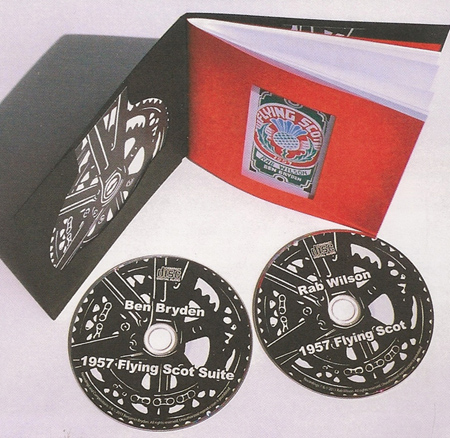
The ‘sonnet redouble’ verse form is very rare in poetry. Fifteen interlinked sonnets; the last line of the first being the first line of the second; the last line of the second being the first line of the third, and so on….. until the last line of the fourteenth sonnet which is the first line of the first sonnet! Then the fifteenth sonnet, that completes the redouble sequence, being a stand-alone sonnet that is made up entirely of the fourteen interconnecting lines of the previous fourteen sonnets! This is an incredible tour de force of poetry writing – and is virtually the K2 of the poetry world! Rab Wilson is the only Scots poet known to have written a sonnet redouble.
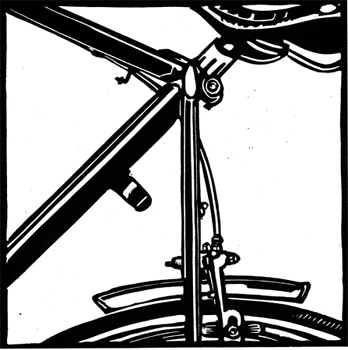
Ben Bryden was a finalist in BBC Scotland’s ‘Young Jazz Musician of the Year’ last year. He has been studying at the New York School of Music these past three years and this week will be receiving his Master’s Degree in Jazz Music. He is one of the most exciting new young jazz prospects in the UK. Ben’s new suite of music to accompany the poems was recorded in Tony Bennet’s recording studio a month ago, using the cream of New York’s up and coming jazz musicians.
Hugh Bryden’s work is well known recognised on a national basis; he was winner of the Callum MacDonald Memorial Award in 2009 for pamphlet poetry, and this year has been short-listed for the prestigious Michael Marks Award.
Alloy in the Thirties: Steve Griffith
Hicking of Hayes: The pioneer of dura-aluminum fittings and accessories.
Buying the 1938 catalogue from this company I was initially attracted by the Patterson sketch on the cover. The cover of a typically British scene was at odds with the inside content which has a wide range of continental fittings, many of them alloy. Mind you, the rear cover of a mass start race suggested a progressive image. Hicking must have been pioneers in this field as this was pre-WW2 when steel was king. Included in alloy are Lapize Tour de France toeclips , drinking bottle and flasks, Zefal pumps, bars and stems rims, Dynamos the Roto-Phare, Brivia chainset, bells, Bowden brakes, pedals, mudguards, seatpins, wing nuts, Maillard hubs and gears (Osgear type) and the Caminargent duraluminium frame.
In fact, pretty much everything you would need to build up a bike. One of their specialities which has subsequently disappeared was the chain oiler fitted to the seat tube which drips oil on the chainring. Also the clip on toeclips as opposed to bolt on ones which would be very useful for moving from one set of pedals to another. Hicking seem to have used the trade name ‘Bell’ for a number of their products. The catalogue is now available on the Classic Lightweights website under Components or Catalogues.
The editor is looking for a close-clearance (with 700s) track frame preferably with drilled front fork but not rear bridge. Size 23/23½”, need not be from 50’s era – a later model would do as long as no braze-ons. Also looking for a similar specification lo-pro track frame.
The close-clearance detail is the important factor. In the 40s and 50s so many track frames were built as road/path with clearance for 700 sprints (known as 27” continentals at the time) for racing. So far, so good. The problem comes when additional clearance is given for 27” ‘working’ wheels and then mudguards on top of this. I have seen pictures of our national stars at championships in Europe in the 50s where everyone else is on frames with the literal ‘fag-paper’ clearance but the UK riders had gaps so big they looked like touring bikes.
May is always a bit hectic for us. On 1 May the Cambridge Cycling Campaign organised The Reach Fair Ride of some 27 miles. There was a turnout of between 3/400 riders leaving the Cambridge Guildhall at 10am. I took my Higgins Ultralight on fixed set up in a modern fashion with an ‘old skool’ feel. Patricia was on her custom-built Donohue. This ride is purely a family fun event with entrants from a few months old (in trailers and seats) to grandfathers and mothers. It amazes me to see these young children on ‘kiddy’ bikes with tiny wheels pedalling like mad for the whole event which celebrates over 800 years of the Reach village fair’s charter. As we rode to the start amongst the crowds I espied a woman riding a sporty Van Nicholas titanium bike. Soon it was announced that the Mayor of Cambridge would flag the ride off and the said Van Nicholas rider mounted the dais complete with mayoral chain, started the ride and then completed the course of 27 miles. Later that afternoon we left for a cycling holiday in Italy.
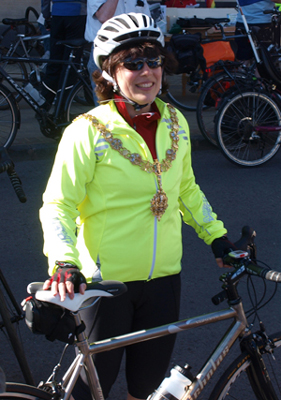
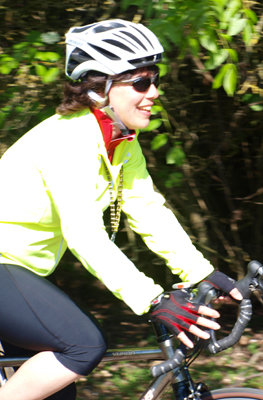
On returning from Italy we held our own V-CC Meridian Lightweight Ride here in Cambridge which attracted 19 riders on a nice selection of classic lightweights, including a Bianchi with Paris/Roubaix gears and a 1939 Rensch with an Osgear. As we use a flat route for this event we encourage fixed wheel machines if possible as well as owners of ‘temperamental’ gears. I rode my Bates Vegrandis on 66” fixed gear and Patricia was on her Paris Tour de France with Simplex gear.
The following weekend was the annual Reading Lightweight Ride with some 50–60 riders, again a terrific range of high-class lightweights. The theme was builders beginning with ‘H’ so I took my Hetchins with gears and left behind the Hobbs and R O Harrison as they were both on fixed and this route is fairly hilly. Patricia rode her Pat Hanlon Pat Hanlon – Pat’s own bike built for her by Tom Board and left behind her Hobbs. This event is the UK’s classic event and has run for many years now. I guess we have been to about a dozen of them and enjoyed every one. Terry and Pauline Pearce have got the organisation of to a ‘T’ and even manage to find a pub able to cope with this influx of riders
Our next event was the Bates Weekend in Dorset, organised by Bob Damper and Penny Cossburn (with the help of a mutual friend Ann). Being a weekend event arrangements have to cover from Friday lunchtime through to Sunday evening. As is traditional, the event was based at a camping site – this time at Sixpenny Handley and the site was able to supply catering for all in a rather nice building called The Shed. Some 40+ riders entered and we got there in time for the informal Friday evening meal which was very enjoyable – plenty to chat about, even discussing the possibility of organising a lightweight ride with dogs in baskets on the front as this seems to be an increasing habit in the V-CC, being a sure-fire way to get your photograph printed in the club magazine.
Organisation of this event was left in the hands of Mark Hudson from Sheffield who was trying to weave a basket for his Irish Wolfhound as we left. I thought of a large basket with a couple of Huskies which could be tipped out at the start of the steep Sheffield hills with leads to the bike and whipped-in to provide some extra propulsion when needed. More eco-friendly than a battery-assisted bike I think.
The next morning we all met again and set off on the first day ride around the pleasant lanes of Dorset around Cranborne. I was on a Bates Vegrandis with 62.1” fixed gear (where are the huskies when you need them!) which was OK with some honking on the steeper hills. Patricia was on her 1944 Bates BAR with the luxury of a Simplex four-speed gear. Saturday evening was a more formal get together for dinner. So far all is well but we had all been watching the weather forecast.
Rain was promised for Sunday and they were certainly right – it was pouring when we woke up on Sunday. Bob took the sensible decision to cancel that day’s ride which was a shame as they had put so much into the organisation. We look forward to next year’s Bates ride. Out of the forty or so riders, three of us were on fixed.
Twenty or so riders started from Norwich and a similar number from Ipswich Bicycle Club started from just outside Ipswich. The Norwich route was along the Ipswich road to Scole(20 miles), turn right and then left towards Ixworth (37 miles), return to Scole (54 miles,) right towards Ipswich and turn at Creeting Hill (73 miles) and back through Scole to Long Stratton (100 miles).
I was riding my Paris Tour de France with a fixed gear of 64″, most of the riders used a similar gear. We were, of course, wearing ordinary winter clothing, long trousers and thick sweaters. The first few miles were quite leisurely into a strong and freezing breeze, but just through Long Stratton some bright spark decided to warm up things and suddenly made a breakaway. I jumped onto the tail of my friend Bill Rix and five of us were away from the bunch. Peter Woodhouse EACC, Robin Keeley Norfolk Road Club, Jimmy Papps, Billy Rix and myself NABC. By the turn at Ixworth we were five minutes ahead and no one was making any effort to catch us. We turned back into the head wind at Scole and headed for Ipswich.
We were working “bit and bit” because the wind had become stronger and it started to snow. The snow became heavier and I had just finished my stint at the front and then, mistake, mistake, I decided to don my plastic cape. By the time I had remounted the others had vanished into the swirling white.
I was confident that I would catch them before long, but suddenly my legs turned to jelly as the dreaded “bonk” hit me. We carried no food or water, but I found a long forgotten half of an old Mars bar in a pocket. This revived me sufficiently to start pushing again. I must admit that I started to wonder what the Hell I was doing in the middle of nowhere in freezing snow and wind when most sane people were sitting at home, warm and dry eating a Sunday lunch, but I was determined not to give up. Just before I reached the turn at the top of Creeting Hill, the other four came tearing down the Hill and amidst rude remarks they quickly vanished. At the top of the hill kind ladies were handing out hot drinks and I gratefully grabbed one and took a big swig. Unfortunately, it was TEA which I cannot stand and it took a long while to lose the revolting taste.
However, it seemed to wake me up as I increased my speed. The snow had abated and I had removed my cape. A mile or before the final check point at the Limes, Long Stratton I saw the other four. With a great effort I managed to catch as they turned into the cafe gates. Inside the cafe we found all the other riders who had given up and turned back towards Norwich at Scole, and had spent the entire afternoon in the cafe drinking tea and scoffing buns. They pitied us and thought that we must have been mad to carry on in such conditions, but at least we eventually had the satisfaction of receiving an illuminated scroll confirming our achievement. (Sad though it might seem, I still have mine!!)
In the following January (1953) I entered the Attleborough C.C. 50-Mile Reliability Trial on my new Gillott track machine and (won) came home first in 2 hrs 35 mins. Not bad on a 64” fixed !
(Ed: 64” fixed was, and is, a way of measuring a single gear in the UK. The figure is number of teeth on chainring x diameter of wheel in inches of course. The sum then divided by the number of teeth on the sprocket. We all knew several ‘standard’ ones by heart but could also work out the others in our head to reasonable accuracy. For example 48 tooth chainring, 27” wheels and 18 tooth sprocket – 48 x 27 equals 1296 which when divided by 18 gives 72”. This is one we all knew along with 48 chainring with 16 sprocket giving 81”. Not all figures were so neat as decimal places came into it more times than not. The resulting gear , say 72”, doesn’t mean that one revolution of the crank will carry you forward 72 “ – that would be rather simple and life isn’t like that. The distance covered assumes one revolution of a wheel of 72” diameter (or whatever the gear is).
Sight, sound, smells and tastes from the past
Memories can be made up from all or some of the senses. In my case I have strong cycling recollections relating to these.
Visual – a picture which is often in my mind is the ‘wall’ of club bikes parked against the railings of Greyfriar’s Tower, King’s Lynn on a Sunday morning when the local time trial was done and dusted. In those days this would be not long after 8 am. Most of the local clubs, King’s Lynn CC and Wisbech Wheelers, would cycle back into the town from the start/finish to visit the cafe opposite the tower leaving some forty to fifty bikes against the railings and not a lock in sight. After a ‘cuppa’ we would all set off for a club run of 100 – 150 miles or even more in the summer.
My memory sound really isn’t a sound at all as it is an eery silence. The silence of a group of about twelve riders out on a training ride in the dark riding fixed-wheel along a road with about an inch of virgin snow on it. I guess part of the silence was due to riders concentrating so as to avoid skidding on the snow when riding with the small amount of light from the Lucas double-cell front lamp. At least the snow acted as a reflector for the glimmer of light. The snow deadened the sound of tyres on the road – until the sound had gone one never realised it was there in the first place.
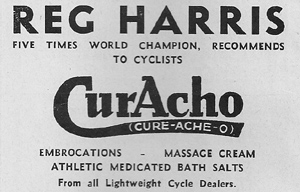
Next comes smell, and what a pungent smell it was, nearly stinging your eyes and nose. There were heavily-advertised muscle treatments on the market: one was Elliman’s Embrocation another said to be Reg Harris’s choice, CurAcho, b ut for some reason, maybe it was cost, all the cyclists I knew came up with their own concoction of olive oil and wintergreen (people also made their own suntan oil from olive oil and vinegar – when this didn’t work the inevitable sunburn was bathed with calamine lotion resulting in bed and breakfast dining rooms full of people looking as if they had been whitewashed – with a subtle hint of pink of course).
My taste recollection is of a cup of hot cocoa with a Lyons fruit pie which was our stable winter refreshment stop. The only alternative in those days, being a vegetarian, was a cheese sandwich with white bread – none of this fancy granary stuff in those days. Another second-hand taste-related item was also visual as my friend Dickie Lines use to swear by a couple of raw eggs whipped into a glass of milk – he was always faster than me so maybe he was right! I never tried it but always felt I would gag rather than swallow it.
The mystery of the welded/brazed frames continues. I have mentioned many times the superb feel and handling of the brazed frames produced by builders famed for their classic lugged frames. We own examples by R O Harrison (Shortwin), Gillott (L’Atlantique), and Mercian. We each also have a Paris Tour de France which is essentially brazed with the addition of bi-laminates at the front of the head only. I also possess a Higgins (Ultralite) which was rather small as a classic build and which I built up as an old-skool, modern style fixed-wheel (fixie!!) for general riding when in the company of the local fixed ‘boys’.
It has 27” HP Weinmann rims on Airlite large-flange D/F hubs, Maes bars upturned and cut off to become bull-horns, Brooks saddle, etc. I have 20T sprocket with 46T chainring so a ‘twiddly ‘ gear. What amazes me is how much I love riding it, I use it whenever possible, even doing shopping runs on it when I can get the shopping into a backpack. The pedals are double sided with SPD one side and flat the other for normal town shoes, and yes, it does have a brake.
Higgins are probably most famous for their lightweight trikes but probably produced more brazed Ultralites than they did the lugged version of it. For a long time I thought Ultralite defined the brazed frame but it was also offered with lugs as an extra, including the infamous Nervex Professional.
“I have several of the top makes from the 50’s, Hetchins, Gillott, Ephgrave etc., and I don’t why, but the Higgins rides better than any of them; could it be that Higgins was an engineer first and a cyclist second!?”. This doesn’t help my theory on brazed frames though as he is referring to a 1956 lugged version known in this case as the ‘Plus Parfait’. Higgins also produced a handful of brazed frames known as the Dunster which has more tubes than London Underground and more joints than Keith Richards ever had. We have one listed in Readers’ Bikes on the website. It is hard to describe it verbally apart from noting a total of six rear stays.
Steve Chambers found this badge a few weeks ago – does anyone know about C C Bon Bon T C?
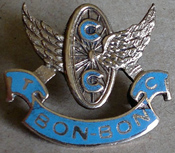
Bill Ives would like to speak to Ron Tandy about Dave Russell but I seem to have lost Ron’s email. Could Ron get in touch with me please.
Posted: Thursday 28th July 2011
Contents
- Introduction
- Rab Wilson
- Sonnet Redouble
- Young Jazz Musician of the Year
- Alloy In The Thirties
- Cambridge Cycling Campaign
- Cambridge Mayor
- V-CC Meridian Lightweight Ride
- Dorset Around Cranborne
- Bates Ride
- Keith Tubby
- Creeting Hill
- Gillott Track Machine
- Tastes From The Past
- CurAcho
- HP Weinmann Rims
- Higgins
- Collector Of Superb Classic Machines
- Badge
This article appears in the following categories.
Upcoming Events
Whether you are looking for a gentle social meet up, or a 100-mile ride browse the community’s upcoming events and plan your next weekend outing.
